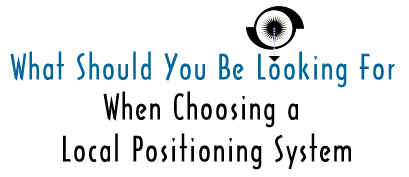
AutomatedBuildings.com
|
[an error occurred while processing this directive] |

"....... a powerful local positioning system must be flexible in its design and in the amount of applications that it can offer. It should be completely open from the component level to the network level and all the way up to the application level."
Ofer Yourvexel, VP
Marketing
ELPAS Ltd
[an error occurred while processing this directive]With more and more corporations and organizations owning multiple sites in various countries around the world. With capital equipment becoming smaller in size, as well as mobile, and with employees needing the freedom to freely move around in this environment, being able to monitor assets location and status in the workplace, in real time, has become a major requirement. Examples for the above include hospitals, which no longer require patients to be brought to the equipment room, but instead now bring the mobile X-Ray machine to the patient. Another example is the horrendous amount of laptop computers that are stolen every year containing vital company intellectual property. With the latest developments in long range RFID and Infra-Red (IR) communication, a solution is no longer a fantasy of some technology geek, given that a new class of cost effective Enterprise Local Positioning Applications and Systems are being implemented successfully all over the world.
The next few suggestions are essential requirements that you should be aiming to look for in an Enterprise Local Positioning System (LPS), when evaluating the purchase of such a system for your facility.
The first question to ask yourself is what type of LPS solutions would benefit your organization and how this is going to influence your LPS requirements. Before conducting this survey, it is recommended to study the different kinds of solutions that vendors are offering today as well as the solutions they are aiming to achieve in the future.

Relevant questions include:
1. Will I need a room resolution, a general area resolution, or even exit resolution?
For the computer location you might settle for a general area but if you expect the system to notify of laptop computers being illegally removed, you will need a door resolution. Hospitals that want to automate their Nurse Call System will need to know the exact Nurse room location. Soon after looking into the different requirements you come to the conclusion that even if you want to start with an area resolution solution, you, nevertheless, want to ensure that the chosen system will offer you the flexibility to improve the resolution in a cost effective manner. Due to the limitations of each individual medium, the most cost effective way to achieve the above is to have a system that supports on the same infrastructure a transmission of low and high RF as well as IR (IRFID™ technology).
2. Variety of Tags: As you implement the system throughout the enterprise you will discover that you need a variety of IRFID™ tags from both a design and functionality perspective. You should carefully examine to ensure that the system you choose includes the correct tags to address your different needs. The following is a list of several examples:
Bear in mind, that the more features these tags offer the more solutions can be applied to the same infrastructure, thereby improving return on investment.
3. Smart RDRs: Conventional systems use sensors to provide input to a "brain" that calculated location only. However, as the world moves more and more toward a distributed intelligence approach, you may decide upon a more advanced system that uses RDRs with distributed intelligence to provide scalability of functions from which you can choose input and output relays that are activated locally by the RDR. This improves reliability and speed reaction.
4. Will location be good enough for me or can I expect to receive more to justify my investment? While conventional system provides information based on the three Ws (not World-Wide Web), I strongly recommend demanding the fourth W as described below:
This can include information such as: Is the equipment plugged in to an electrical outlet? If it is plugged in- is it currently in use? If it is in use, what is the equipment's utilization level (remaining battery level, oxygen level used, temperature, and more)?
5. An open Standard Network Architecture should be applied. A good example of such a network is the Echelon LonWorks™ network, which has an easy "Plug & Drop" concept, providing the following three benefits:
6. Flexible Software Architecture: A Local Positioning System should be flexible enough to offer the following capabilities:
In conclusion, if one wanted to combine all the above suggestions into one main idea, it would be worth remembering that in this fast-moving, fast-changing and complex business-world, a powerful local positioning system must be flexible in its design and in the amount of applications that it can offer. It should be completely open from the component level to the network level and all the way up to the application level. These two guiding principles ensure that you receive better return on your assets (ROA) as well as on the system itself and increases your chances of meeting the demands of any organization not only today, but also in the future.
[an error occurred while processing this directive]
[Click Banner To Learn More]
[Home Page] [The Automator] [About] [Subscribe ] [Contact Us]